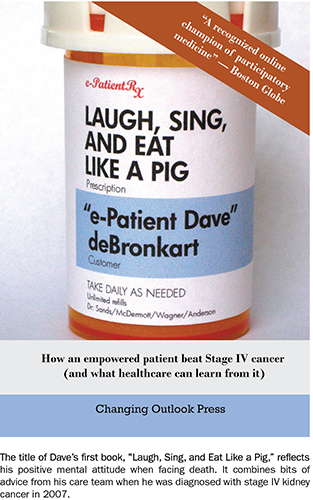Beyond Empowerment: Patients, Paradigms, and Social Movements

Carr: It sounds like you’re talking about a paradigm shift.
deBronkart: Yes, I am talking About a paradigm shift, but in the rigorous sense used by Thomas Kuhn in his classic book, The Structure of Scientific Revolutions (1962). Kuhn usually calls it a paradigm change (not shift), which he describes as one that alters our beliefs, the fundamental concepts in our view of the world.
The best-known paradigm change is the Copernican revolution: “Oops, sorry, the Earth’s not the center of the solar system!” Long ago, everyone knew the earth was flat. They also could see that stars and planets orbited around the Earth. But there was a problem: Mars mostly circled around us, but sometimes it backed up! Kuhn called such problems “anomalies,” saying they’re “violations of expectation,” something that isn’t possible in our current paradigm. It took a long, long time before we shifted our paradigm to accept that the Sun is at the center, and that the Earth circles around it. Mars isn’t misbehaving; it’s our peer.
I love looking at the progress of human understanding as paradigms evolve. Ancient Greeks explained the arc of a swinging pendulum by saying it was trying to get as low as it could, and was doing a bad job! Newton figured out a better paradigm: The pendulum just is what it is as it responds to gravitational force. That created a new view of how things work, which opened up new scientific thinking.
The point here is that as human knowledge progresses, becoming more and more accurate, our ability to explain observations improves, as does our ability to predict how to get a desired result. That’s what I want in healthcare: a new understanding of how things work, including what’s possible for patient contributions. Better knowledge leads to better decisions.
Thought leaders like Tom Ferguson and every great thinker in the patient world envision a future that will be possible when we rethink what patients are capable of. Then we can ask, “How might we enable that change?” That’s where the thought leadership rubber meets the road.
Carr: Please say more about Tom Ferguson! At the start of this conversation, I said you helped advance the e-patient movement. Ferguson was the visionary physician who started the movement, wasn’t he?
deBronkart: Yes, he was. Kuhn notes that almost every new paradigm—every transformational new way of understanding a field—has come from someone who was not experienced in the field. Newton was 23 when he figured out gravitation. Einstein was 26 when he proposed relativity. So it was with Tom Ferguson.
When he was about 40 years old, Ferguson published a magazine and then a book titled Medical Self-Care (1980). He saw that the great majority—70% to 80%—of healthcare is self-care. Later, he was the medical editor of the millennium edition of the Whole Earth Catalog (Rheingold, 1994), the hippie journal of self-reliance.
He saw that when healthcare turns to medical care to address a serious problem, lack of information holds patients back. When the Web came along, access exploded: Not only could patients find information, they could find other patients and share advice. Ferguson coined the term “e-patients,” with the “e” meaning not just “electronic,” but also “equipped, engaged, empowered, and enabled” (2007).
The insight that led to the founding of this movement was the realization that access to information is a key enabler of value in healthcare. When access changed, the reality of patient power changed. Within the establishment, however, the paradigm of the patient (the agreed-upon conception of what patients can do) hadn’t caught up. That’s still happening.
Carr: You and other members of the e-patient movement talk with optimism and hope about these changes, while others react with resistance and antagonism. How do you stay so positive?
deBronkart: Role changes are hard; I empathize with the plight of good people whose world is experiencing an earthquake. My work in business was always to introduce new things—the “arriving future,” as I call it. The greatest compliment I get after a speech is if someone says, “You know, I never thought of it that way.”
It takes work to see new things that are unimaginable in our experience. A horseless carriage? A flying machine? Walking around the house with a telephone attached to nothing, video chatting with people in Japan? That’s preposterous! Oh, and a century later, that horseless carriage is driverless? Insane! And what do you mean, they emailed a wrench into outer space? All those things became possible after other things became possible; it’s the stuff over the horizon that Kurzweil said is so hard to anticipate.
The change in access to information illustrates Kurzweil’s idea that one innovation sets the stage for other innovations. At a deeper level, the change enables what Kuhn discussed: a fundamental shift in what we can even imagine is possible, something that forces us to change how we think about things.
During any social change, things can get nasty. In medicine, Ignaz Semmelweis was deemed crazy because he proposed something simple—handwashing!—that medical science of his era had no way to explain because they didn’t yet know about bacteria. (Washing away invisible things that cause pus? Preposterous! Unscientific!) He didn’t relent and was committed to an asylum, where he died at age 46 (“Ignaz Semmelweis,” 2016).
The point is that it’s human nature not to believe something is possible if it doesn’t fit into the current view. To see the new truth, we have to shift the foundations of what we believe is possible. That’s the work of this movement.
